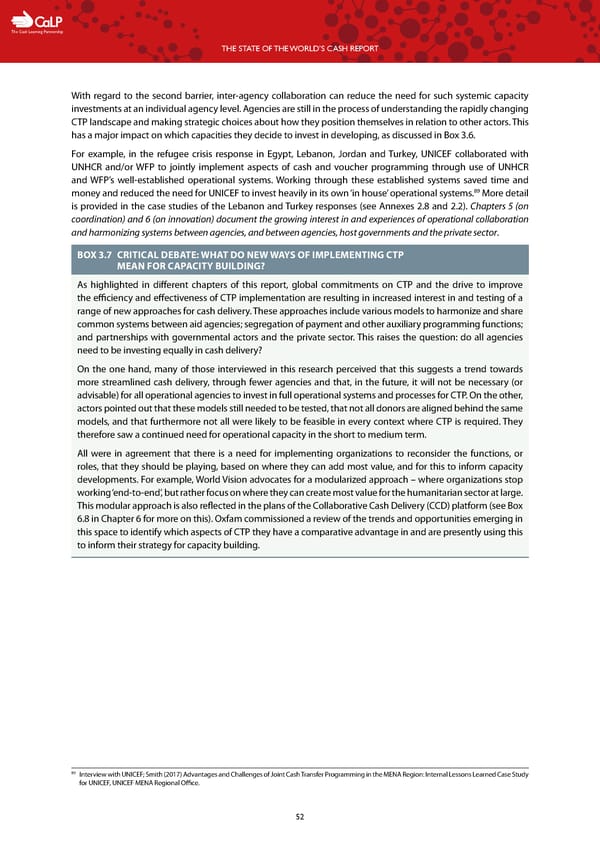C The Cash Learning Partnership THE STATE OF THE WORLD’S CASH REPORT With regard to the second barrier, inter-agency collaboration can reduce the need for such systemic capacity investments at an individual agency level. Agencies are still in the process of understanding the rapidly changing CTP landscape and making strategic choices about how they position themselves in relation to other actors. This has a major impact on which capacities they decide to invest in developing, as discussed in Box 3.6. For example, in the refugee crisis response in Egypt, Lebanon, Jordan and Turkey, UNICEF collaborated with UNHCR and/or WFP to jointly implement aspects of cash and voucher programming through use of UNHCR and WFP’s well-established operational systems. Working through these established systems saved time and money and reduced the need for UNICEF to invest heavily in its own ‘in house’ operational systems.89 More detail is provided in the case studies of the Lebanon and Turkey responses (see Annexes 2.8 and 2.2). Chapters 5 (on coordination) and 6 (on innovation) document the growing interest in and experiences of operational collaboration and harmonizing systems between agencies, and between agencies, host governments and the private sector. BOX 3.7 CRITICAL DEBATE: WHAT DO NEW WAYS OF IMPLEMENTING CTP MEAN FOR CAPACITY BUILDING? As highlighted in different chapters of this report, global commitments on CTP and the drive to improve the efficiency and effectiveness of CTP implementation are resulting in increased interest in and testing of a range of new approaches for cash delivery. These approaches include various models to harmonize and share common systems between aid agencies; segregation of payment and other auxiliary programming functions; and partnerships with governmental actors and the private sector. This raises the question: do all agencies need to be investing equally in cash delivery? On the one hand, many of those interviewed in this research perceived that this suggests a trend towards more streamlined cash delivery, through fewer agencies and that, in the future, it will not be necessary (or advisable) for all operational agencies to invest in full operational systems and processes for CTP. On the other, actors pointed out that these models still needed to be tested, that not all donors are aligned behind the same models, and that furthermore not all were likely to be feasible in every context where CTP is required. They therefore saw a continued need for operational capacity in the short to medium term. All were in agreement that there is a need for implementing organizations to reconsider the functions, or roles, that they should be playing, based on where they can add most value, and for this to inform capacity developments. For example, World Vision advocates for a modularized approach – where organizations stop working ‘end-to-end’, but rather focus on where they can create most value for the humanitarian sector at large. This modular approach is also reflected in the plans of the Collaborative Cash Delivery (CCD) platform (see Box 6.8 in Chapter 6 for more on this). Oxfam commissioned a review of the trends and opportunities emerging in this space to identify which aspects of CTP they have a comparative advantage in and are presently using this to inform their strategy for capacity building. 89 Interview with UNICEF; Smith (2017) Advantages and Challenges of Joint Cash Transfer Programming in the MENA Region: Internal Lessons Learned Case Study for UNICEF, UNICEF MENA Regional Office. 52
 The State of the World's Cash | Full Report Page 53 Page 55
The State of the World's Cash | Full Report Page 53 Page 55